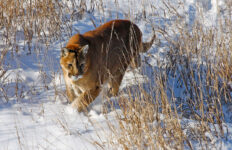
Following the science on big cat populations and wildlife management • Colorado Newsline
As wildlife scientists devoted to rigorous independent research, we wish to inform Coloradans what the best peer-reviewed and published science says about mountain lion and bobcat trophy hunting.
Voters deserve to know without bias what are mere assumptions without proof, and what are science-based facts backed up by evidence.
As journalists dive into wildlife science, they too should realize that all opinions are not equal when it comes to science, and everyone — including our government agencies — ought to be fact-checked based on scientific research.
GET THE MORNING HEADLINES.
The big question: Does Colorado’s current program, allowing citizens to kill 500 mountain lions and about 1,000 bobcats every year, have any positive or negative effect on wild cats or other wildlife populations, on public safety, or on domestic animals like cattle and dogs — and if so, what?
As you might imagine, mountain lion populations are not at all like prey animals. Lions are territorial, and do not tolerate the presence of other lions residing within their vast ranges — unlike deer, for instance, which congregate and are easy to spot. There are about 4,000 lions in Colorado, but we don’t have precise estimates because their shy, elusive nature makes them difficult to count.
Science confidently informs Coloradans that mountain lion populations self-regulate. In layman’s terms, that means that trophy hunting is not managing their populations, and that they will not explode in the absence of trophy hunting.
World-renowned big cat researcher Maurice Hornocker, in his book “Cougars on the Cliff,” explains that mountain lions “regulate their own numbers and actually help prey animals maintain or increase their population numbers.”
In California — a state without trophy hunting for the last 52 years — lion populations remain stable, not increasing, and just 15 are killed each year for predation on livestock.
Without exploding lion populations, assumptions about decimating deer, as some would claim, are false, according to researchers. Colorado Parks and Wildlife researchers, among others, have provided ample studies to show that in layman’s terms, where there are fewer lions, there will be fewer deer and vice versa. Nature has its own way of balancing without artificial interference.
In terms of public safety, pets, and livestock, multiple studies show that trophy hunting does nothing to make us, our pets, or livestock any safer than we already are. In fact, there is evidence to suggest that when you take out what is typically considered a trophy lion — a large resident male, living longer in coexistence — you invite conflict to the region by opening up his territory to juveniles that are more likely to get into trouble.
In sum, the recreational killing of lions and bobcats, which allows keeping heads and selling fur as recreational choice or commercial business, does not solve any true management need; it neither reduces human-lion conflict, nor prevents depredations; it will not make humans wandering in the woods or pets at home any safer than families already are.
The science also informs us that there is a proven, effective way to prevent conflict between lions and livestock, pets, and people: to identify individual lions that pose risk, and have the professionals verify and handle them as they see fit.
On bobcats, Colorado has no estimated population count. Bobcats are allowed to be trapped during the season in unlimited numbers. Live traps set with bait are allowed to be unattended for 24 hours, and there is documentation showing lynx have been accidentally trapped where habitats overlap.
Because recreational trophy hunting and commercial fur trapping are not managing anything, the question of whether we wish to keep allowing it is one of social science, or ethics. That is beyond our expertise, but a Colorado State University survey found that 88% of Coloradans disapproved of hunting mountain lions with dogs, which is how lion hunting is done in Colorado because lions are so shy.
It’s good overall that Colorado is having this conversation for the science to be accessible to the public.
Furthermore, there is a whole body of science on the ecological services of mountain lions and bobcats that deserves equal attention. Apex predators serve to keep whole ecosystems healthy, and that is increasingly important today as we are losing our biodiversity so quickly across the map.
So let’s all follow the science, as well as our ethics, and the environmental goals of Colorado, as we stay attuned to this important conversation.
YOU MAKE OUR WORK POSSIBLE.


